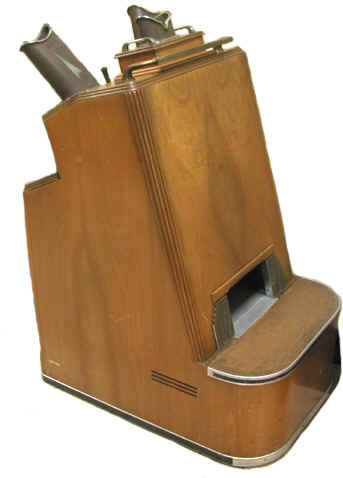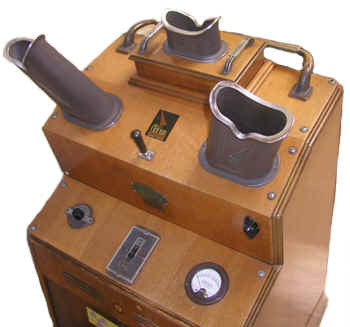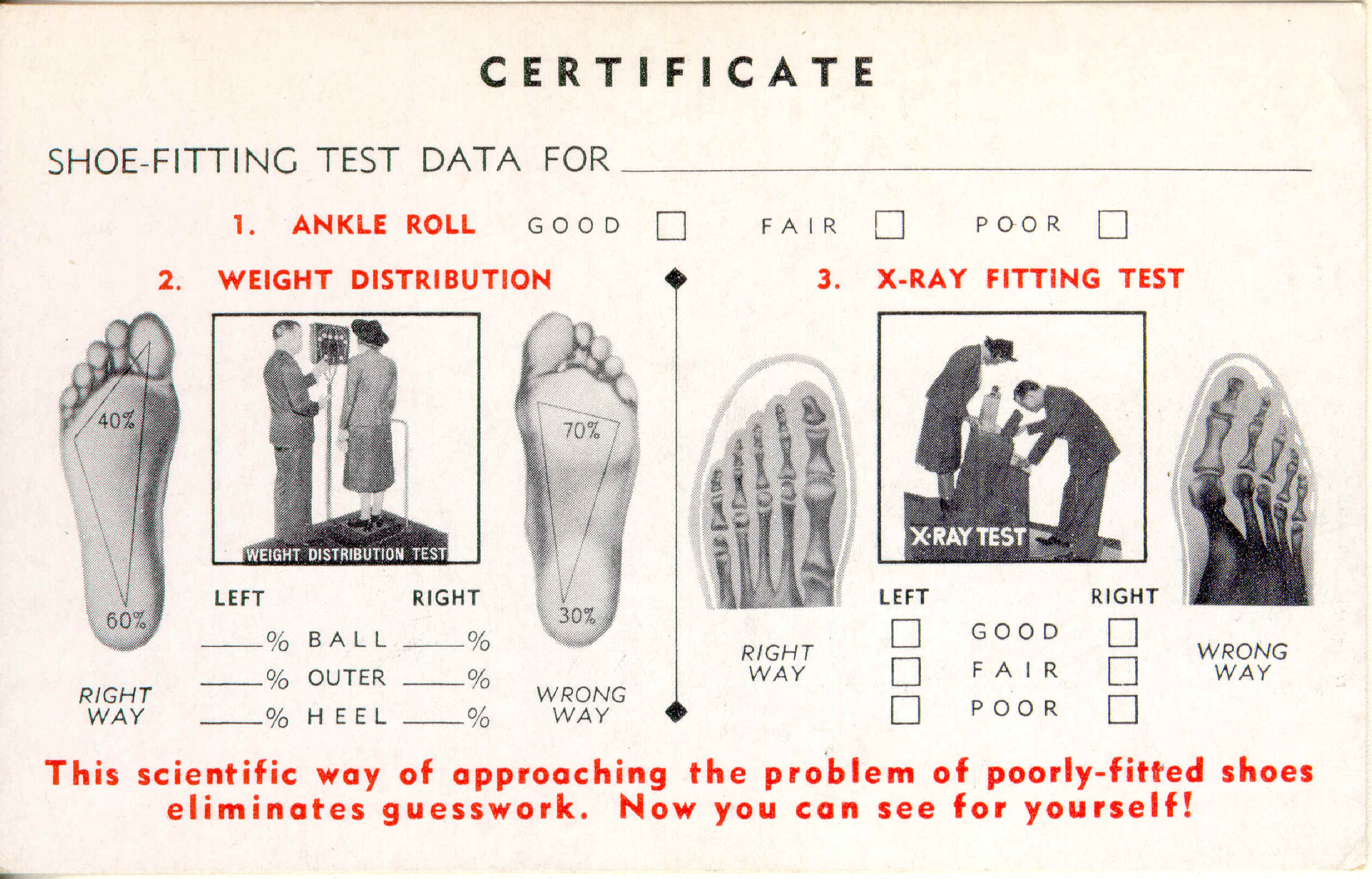Shoe-Fitting Fluoroscope (ca. 1930-1940)
Basic Description
The shoe fitting fluoroscope was a common fixture in shoe stores during the 1930s, 1940s and 1950s. A typical unit, like the Adrian machine shown here, consisted of a vertical wooden cabinet with an opening near the bottom into which the feet were placed. When you looked through one of the three viewing ports on the top of the cabinet (e.g., one for the child being fitted, one for the child's parent, and the third for the shoe salesman or saleswoman), you would see a fluorescent image of the bones of the feet and the outline of the shoes.


According to Williams (1949), the machines generally employed a 50 kv X-ray tube operating at 3 to 8 milliamps. When you put your feet in a shoe fitting fluoroscope, you were effectively standing on top of the X-ray tube. The only “shielding” between your feet and the tube was a one mm thick aluminum filter. Some units allowed the operator to select one of three different intensities: the highest intensity for men, the middle one for women and the lowest for children.
Most units also had a push button timer that could be set to a desired exposure time, e.g., 5 to 45 seconds. The most common setting was 20 seconds.
Jacob J. Lowe—Inventor of the Shoe Fitting Fluoroscope
X-ray images of feet inside shoes and boots were produced for various reasons long before the invention of the shoe fitting fluoroscope. However, it is the origin of the latter that we are concerned with here.
Baring the Sole: The Rise and Fall of the Shoe-fitting Fluoroscope by Duffin and Hayter (2000) has to be considered the best historical account. Although Duffin and Hayter’s account is somewhat noncommittal in this regard, it is hard to avoid concluding that Dr. Jacob Lowe, a Boston physician, has the strongest claim to the title, “inventor of the shoe-fitting fluoroscope.”
According to Duffin and Hayter, Lowe created his first fluoroscopic device for x-raying feet during World War I. By eliminating the need for his patients to remove their boots, the device sped up the processing of the large number of injured military personnel who were seeking his help. After the war, he modified the device for shoe-fitting and showed it for the first time at a shoe retailer’s convention in Boston in 1920. Although the application date for Lowe’s patent (1,614,988) was February 6, 1919, the patent wasn’t granted until January 18, 1927. For some reason, Lowe assigned his patent to the Adrian Company of Milwaukee. Perhaps Lowe sold his interests in the device to Adrian so that he could return to being a full-time physician.
The name Lowe gave too his invention was the Foot-O-Scope, and the company that he formed to produce it was the X-Ray Foot-O-Scope Corporation, Inc. The latter, incorporated in 1920, was located at 100 Boylston Street (room 525) in Boston, Massachusetts. Nevertheless, the machine was actually manufactured in Lynn, Massachusetts by the Campbell Electric Company. Made of mahogany, it wasn’t cheap. The $900 price represented a major investment for a shoe store that wanted one.
The earliest reference that I have found to the use of the Foot-O-Scope was a short note in the March 14, 1920 issue of the Pittsburgh Post-Gazette. It described how the “Foot O’ Scope” detected a misaligned big toe on the left foot of a Boston lion tamer.
By September and October of 1920, shoe store newspaper ads began featuring the Foot-O-Scope (e.g., New York Times, September 13, 1920). The last such advertisement I can find dates from November of 1929.
Clarence Karrer’s Claim to have Invented the Shoe Fitting Fluoroscope
There is a story to the effect that the first shoe-fitting fluoroscope was built in Milwaukee sometime around 1924 by Clarence Karrer who worked for his father, a dealer in surgical supplies and X-ray equipment. After selling several such units to shoe manufacturers and retailers, Karrer was asked by the Radiological Society of North America and some radiologists to stop because it "lowered the dignity of the profession of radiology." Karrer complied, but another of his father's employees quit the company and patented the device. This “history” of the shoe fitting fluoroscope comes from a letter written by Peter Valaer in 1978. In the letter, Valaer recounts how he had a chance meeting with Karrer who told him the story. Parts of the story check out. At the time in question, Karrer did work for a surgical supplies company in Milwaukee.
Matthew B. Adrian’s Claim to have Invented the Shoe Fitting Fluoroscope
The possibility that Matthew B. Adrian was the inventor of the shoe-fitting fluoroscope is certainly credible.
The following quote is from from Matthew’s write-up in the National Cyclopedia of American Biography (Vol. 43. Page 437, 1961):
“In 1905 he entered the employ of a medical X-ray firm known as the Milwaukee (Wis.) X-Ray Laboratory. While with that firm he developed X-ray machines to X-ray oranges, candy, tires, cheese and shoes and in 1917 obtained a patent for the X-ray machine used for fitting shoes.”
The following additional details were provided by Adrian, Matthew’s brother (Fond du Lac Commonwealth Reporter, January 13, 1966):
"Matthew got the idea for the X-ray machine. His son had infantile paralysis, and he saw a need for fitting shoes by X-ray. We built them in Milwaukee. At that time I was working on automatic pianos and phonographs in Fond du Lac, and I'd also work on the X-ray machines in Milwaukee. We sold about one X-ray machine a month for about $850 to $950."
Although the Cyclopedia article indicated that Adrian obtained a patent for his shoe-fitting fluoroscope in 1917, this wasn’t the case. Adrian applied for the patent (1,619,962) January 22, 1923 and it wasn’t granted until March 8, 1927.
The earliest mention I can find of the Adrian X-Ray Shoe Fitter was in the November 25, 1922 issue of the Boot and Shoe Recorder.
For what it is worth, Adrian identified his occupation in the 1922 Milwaukee City Directory as an electrician. He wasn’t listed in the 1919, 1920, or 1921 directories.
The Pedoscope
At more or less the same time that the Foot-O-Scope and Adrian X-ray Shoe Fitter came along, a similar device known as the Pedoscope was invented in Great Britain. The patent for the Pedoscope (No. 248,085) was applied for in 1924 and granted in 1926. Nevertheless, in 1925 the Pedoscope Company claimed that their device had been “in continuous daily use throughout the British empire for five years.” (London Times, Dec. 31, 1925).
The following is from an article in the Manitoba Free Press dated January 2, 1922:
"New X-Ray Device. Holiday shoppers in London now stop at Baber's Ltd., a retail shoe store in Oxford street to see how his or her foot appears inside the shoe and if it is really a true-fitting shoe. This up-to-date shop has installed an X-ray apparatus by which shadow pictures of the foot are made upon plates and the customer has the satisfaction of seeing whether or not the shoe pinches the foot."
Manufacturers of Shoe-Fitting Fluoroscopes (ca. 1950)
Around 1950, the two largest manufacturers of shoe fitting fluoroscopes were:
X-Ray Shoe Fitter Corporation
3535 South Palmer Street
Milwaukee, Wisconsin
(manufactured the Adrian and Simplex lines)Pedoscope Company
St. Albans
United Kingdom
Other U.S. manufacturers:
Primex Equipment Company
135 South LaSalle Street
Chicago, IllinoisB. Adrian & Sons
2507 South Howell Avenue (also 352 E Ward Street)
Milwaukee, WisconsinX-Ray Industries, Inc.
5934 West Walton Street
Chicago, Illinois
In the early 1950’s, estimates placed the number of operating units in the United States, the United Kingdom and Canada at 10,000, 3,000 and 1,000 respectively.
Safety Concerns and the Legislative Response
In 1946, the American Standards Association established a “safe standard or tolerance dose,” that the feet receive no more than 2 R per 5 second exposure. Children were not to receive more than 12 such exposures in a single year. The State of New York adopted similar requirements in 1948, and other states and major cities began to follow suit. As a result, the manufacturers of shoe fitting fluoroscopes became concerned that their products would have to meet a myriad of standards that varied from location to location, and they asked the American Conference of Governmental Industrial Hygienists (ACGIH) to recommend a uniform set of standards. The ACGIH did so and issued their guidance in 1950, an event that allowed the manufacturers to advertise that they met the ACGIH standards.
By the early 1950s, a number of professional organizations had issued warnings about the continued use of shoe-fitting fluoroscopes, e.g., the ACGIH, American College of Surgeons, New York Academy of Medicine and the American College of Radiology. At the same time, the District of Columbia issued regulations that shoe fitting fluoroscopes could only be operated by a licensed physiotherapist. A few years later, Massachusetts passed regulations requiring that the machines be operated by a licensed physician. In 1957 the State of Pennsylvania became the first jurisdiction to ban the use of shoe fitting fluoroscopes. By 1960, these events, plus pressure from insurance companies, had led to the demise of the shoe-fitting fluoroscope, at least in the U.S. In the end, the shoe stores were probably just as glad to be rid of the things—at least one survey had indicated that the machines were perceived by shoe salesmen a sales gimmick rather than a useful tool.
Attempts to impose regulatory restrictions on the use of shoe fitting fluoroscopes seem to have been limited to the United States. Despite considerable effort, Jacalyn Duffin and Charles Hayter, authors of the aforementioned “Baring the Sole: The Rise and Fall of the Shoe Fitting Fluoroscope,” could not find any Canadian or British legislative action pertaining to these devices. In fact, Duffin and Hayter noted that these machines continued to be used in Canada and the UK, albeit to a limited extent, at least until 1970.
Radiation Exposures
While the exposure rates associated with these machines varied considerably, the measurements reported by various authors are reasonably consistent.
According to Moeller (1996), measurements performed during the late 1940s indicated that the doses to the feet ranged from 7 to 14 R for a 20 second exposure. Doses to the pelvis ranged from 30 to 170 mrem. He also noted that surveys at the time indicated that more than 60 percent of inspected machines exceeded the American Standards Association recommendation of 2 R to the feet per five second exposure.
According to Duffin and Hayter (2000), a 1948 survey of x-ray machines in Detroit indicated that the exposure rates at the position of the feet ranged from 16 to 75 R/min.
Measurements performed by Williams (1949) ranged from 0.5 to 5.8 R/second to the feet. He also reported exposure rates that were above 100 mR/hr at a distance of ten feet from the front of the unit.
Bavley (1950) reported measurements of 1 to 175 mR/hr (60 mR/hr average) at a height of 18 inches above the floor and 9 inches away from the sides of the machine. The exposure rates 5 feet in front of the machine and 18 inches above the floor were as high as 65 to 160 mR/hr (average: 114 mR/hr)
Despite these relatively high exposures, there were no reported injuries to shoe store customers. Unfortunately, the same cannot be said for the operators of these machines. Many shoe salespersons put their hands into the x-ray beam to squeeze the shoe during the fitting. As a result, one saleswoman who had operated a shoe fitting fluoroscope 10 to 20 times each day over a ten year period developed dermatitis of the hands. One of the more serious injuries linked to the operation of these machines involved a shoe model who received such a serious radiation burn that her leg had to be amputated (Bavley 1950).
Excerpts from Installation Directions
“Before putting the tube in the X-ray machine, place the machine in the most desirable location... We would suggest that you center the machine in the store so that it will be equally accessible from any point. Of course, it should face the ladies’ and children’s departments by virtue of the heavier sales in these departments.”
“At some time or other a customer may request an examination of the foot without the shoe for diagnosing a bone condition. We suggest that you refer this work to the professional man, and advise your customer to have an X-ray laboratory or doctor whose office is equipped with X-ray, make this inspection."
Text of Magazine/Newspaper advertisement (ca. late 1940s)
They’ll Need Their Feet All Through Life.
Guard their foot health carefully through correctly fitted shoes. To help ensure better fit, leading shoe stores use the ADRIAN X-Ray Machine. Whether the shoe clerk is an “old timer” with 20 or more years of fitting experience or a “Saturday extra” who has been on the job only a few weeks, ADRIAN X-Ray Machines help him give your child the most accurate fitting possible.
The ADRIAN fluoroscopic X-ray picture illustrated above clearly shows correct or incorrect fit in an instant. Shoes that are too short or too long, too wide or too narrow, or even too pointed, are immediately indicated in an easily viewed instantaneous picture. You SEE your child’s foot IN THE SHOE.
The new Adrian “Special” shown here is the latest development in fluoroscopic X-ray shoe fitting equipment. Built in full compliance with American Standards Association requirements as well as all other applicable government specifications, the new Adrian has met rigid requirements and has been awarded the Parent’s Magazine Seal of Commendation. The new ADRIAN can be found in better retail shoe and department stores everywhere. Ask for fitting by ADRIAN... it will assure you of foot health and comfort. And remember, SHOES THAT FIT WELL - LAST LONGER!"
Text for Radio Commercial
"Every parent will want to hear this important news! Now, at last, you can be certain that your children’s foot health is not being jeopardized by improperly fitting shoes. STORE NAME is now featuring the new ADRIAN Special Fluoroscopic Shoe Fitting machine that gives you visual proof in a second that your children’s shoes fit. The ADRIAN Special Shoe Fitting machine has been awarded the famous PARENT’S MAGAZINE Seal of Commendation... a symbol of safety and quality to millions of parents all over America. If your children need new shoes, don’t buy their shoes blindly. Come in today, let us show you the new, scientific method of shoe fitting that careful parents prefer. STORE NAME invites all of you to visit us today for an interesting demonstration. We know that once you buy shoes that are scientifically fitted, you will shop at STORE NAME all of the time."
References
- Bavley, H. Shoe-fitting with X-ray. National Safety News 62 (3):33, 107-111; 1950.
- Directions for Installing and Operating the Adrian X-ray Shoe Fitter. No date.
- Duffin, J., Hayter, C.R.R. Baring the Sole: The Rise and Fall of the Shoe-fitting Fluoroscope. Isis, 91 (2): 260-282; 2000.
- Fredrick, W.G., Smith, R.G. Fifty Years of Progress: 1940-1990 X-ray Shoe Fitting Machine: 1948. Am. Ind. Hyg. Quart. 9 (4): 89-93; 1948.
- Hempelmann, L.H. Potential Dangers in the Uncontrolled Use of Shoe-Fitting Fluoroscopes: 335-336. New Eng. J. Med. Sept. 1, 1949.
- Lowe, J.J. Method and Means for Visually Determining the Fit of Footwear. U.S. Patent No. 1,614,988. 1927.
- Moeller, D.W. A Historical Note—The Shoe-Fitting Fluoroscope. HPS Newsletter. June 1996:6-8.
- Valaer, P. Letter to Dr. Lemay. Dec. 28 1978.
- Williams, C.R. Radiation Exposures from the Use of Shoe-fitting Fluoroscopes. New Eng. J. Med. Sept. 1, 1949: 333-335.

What is a shoe-fitting fluoroscope?
People over age 65 are likely to remember this item from shopping for shoes with their mothers. Paul Frame, Ph.D., a health physicist and trainer at ORAU and curator of the health physics collection, talks about how the device helped kids, parents and shoe salesmen see the bones of their feet and determine which shoe size was the best fit.
